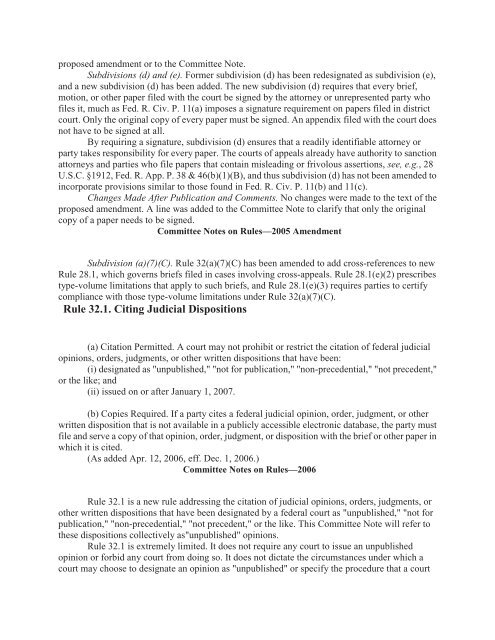Federal Rules of Appellate Procedure 2014-2015, 2014a
Federal Rules of Appellate Procedure 2014-2015, 2014a
Federal Rules of Appellate Procedure 2014-2015, 2014a
Create successful ePaper yourself
Turn your PDF publications into a flip-book with our unique Google optimized e-Paper software.
proposed amendment or to the Committee Note.<br />
Subdivisions (d) and (e). Former subdivision (d) has been redesignated as subdivision (e),<br />
and a new subdivision (d) has been added. The new subdivision (d) requires that every brief,<br />
motion, or other paper filed with the court be signed by the attorney or unrepresented party who<br />
files it, much as Fed. R. Civ. P. 11(a) imposes a signature requirement on papers filed in district<br />
court. Only the original copy <strong>of</strong> every paper must be signed. An appendix filed with the court does<br />
not have to be signed at all.<br />
By requiring a signature, subdivision (d) ensures that a readily identifiable attorney or<br />
party takes responsibility for every paper. The courts <strong>of</strong> appeals already have authority to sanction<br />
attorneys and parties who file papers that contain misleading or frivolous assertions, see, e.g., 28<br />
U.S.C. §1912, Fed. R. App. P. 38 & 46(b)(1)(B), and thus subdivision (d) has not been amended to<br />
incorporate provisions similar to those found in Fed. R. Civ. P. 11(b) and 11(c).<br />
Changes Made After Publication and Comments. No changes were made to the text <strong>of</strong> the<br />
proposed amendment. A line was added to the Committee Note to clarify that only the original<br />
copy <strong>of</strong> a paper needs to be signed.<br />
Committee Notes on <strong>Rules</strong>—2005 Amendment<br />
Subdivision (a)(7)(C). Rule 32(a)(7)(C) has been amended to add cross-references to new<br />
Rule 28.1, which governs briefs filed in cases involving cross-appeals. Rule 28.1(e)(2) prescribes<br />
type-volume limitations that apply to such briefs, and Rule 28.1(e)(3) requires parties to certify<br />
compliance with those type-volume limitations under Rule 32(a)(7)(C).<br />
Rule 32.1. Citing Judicial Dispositions<br />
(a) Citation Permitted. A court may not prohibit or restrict the citation <strong>of</strong> federal judicial<br />
opinions, orders, judgments, or other written dispositions that have been:<br />
(i) designated as "unpublished," "not for publication," "non-precedential," "not precedent,"<br />
or the like; and<br />
(ii) issued on or after January 1, 2007.<br />
(b) Copies Required. If a party cites a federal judicial opinion, order, judgment, or other<br />
written disposition that is not available in a publicly accessible electronic database, the party must<br />
file and serve a copy <strong>of</strong> that opinion, order, judgment, or disposition with the brief or other paper in<br />
which it is cited.<br />
(As added Apr. 12, 2006, eff. Dec. 1, 2006.)<br />
Committee Notes on <strong>Rules</strong>—2006<br />
Rule 32.1 is a new rule addressing the citation <strong>of</strong> judicial opinions, orders, judgments, or<br />
other written dispositions that have been designated by a federal court as "unpublished," "not for<br />
publication," "non-precedential," "not precedent," or the like. This Committee Note will refer to<br />
these dispositions collectively as"unpublished" opinions.<br />
Rule 32.1 is extremely limited. It does not require any court to issue an unpublished<br />
opinion or forbid any court from doing so. It does not dictate the circumstances under which a<br />
court may choose to designate an opinion as "unpublished" or specify the procedure that a court


















